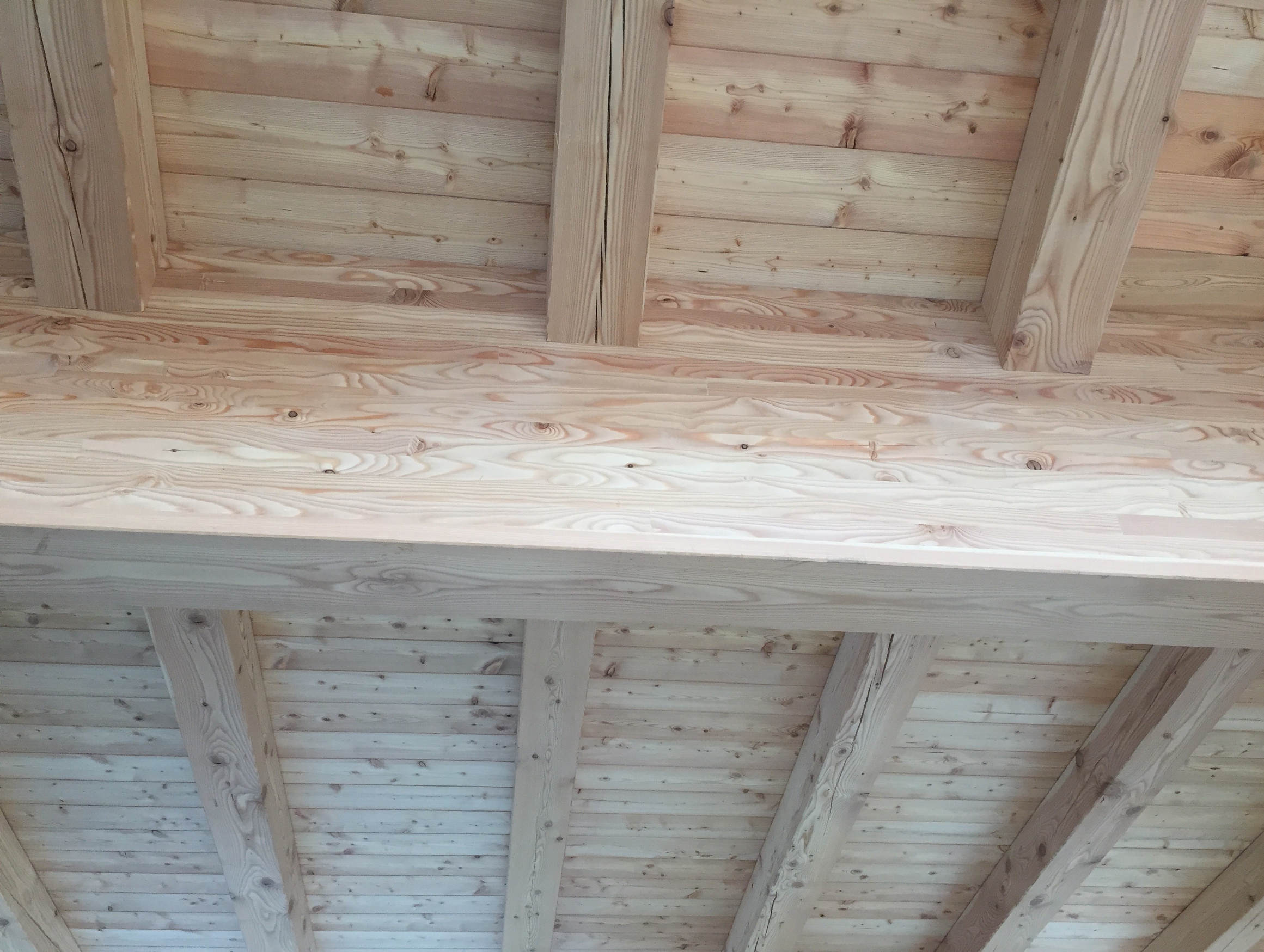Today’s roof trusses of new buildings have the character of the so-called modern hammerbeam systems or modern trusses with purlins. Very often the roof trusses complete the interiors of the buildings in a spectacular way, i.e. they are visual, in the interior they are admitted.
Larch roofs should be chosen especially if the roof is a full or partial view roof, i.e. if the wooden elements remain visible. In other words, larch is the best choice for exposed trusses.
The overall impression of the exposed wood is then enhanced in the interior by the structure of the larch and its color shade. Outside, for example, the protruding rafters have a much longer life span, it is not necessary to keep painting them and the larch wood will get its natural patina and greyish color over the years. Larch rafters are the right choice…

WHAT ARE LARCH TRUSSES?
Larch trusses are structural members made from larch wood, which are used primarily to support the roof covering and transfer its weight to the supporting structure of the building. Larch wood is popular for its high strength , weather resistance and long life , making it an ideal material for outdoor use, including trusses.
Properties of larch wood
Strength and toughness : Larch is known for its high strength and toughness, which ensures the stability and safety of structures
Durability : Larch wood has natural oils and resins that make it resistant to rot, mold, and wood-destroying insects. This property allows larch to last outdoors without the need for surface treatment for 15 to 25 years.
Aesthetics : Larch wood has an attractive appearance with a reddish core and light sapwood, which contributes to the aesthetic impression of buildings.
Use of larch trusses
Larch trusses are used in various types of buildings, including single-family homes, cottages, and historic buildings. They are ideal for:
Traditional wooden structures : In the past, larch trusses were very popular, especially in older buildings
Modern applications : Spruce or pine wood is more commonly used today, but larch remains the preferred choice for specific projects requiring higher durability.
Larch trusses are a quality choice for construction projects where durability and aesthetics are important. Thanks to their properties, they are able to ensure a long service life and structural stability.
WHAT TYPE OF INSULATION IS BEST FOR LARCH TRUSSES?
To insulate a larch truss, it is important to choose materials that provide effective thermal protection and protection against moisture.
Recommended types of insulation
Vacuum insulation
Efficiency : This thin insulation has a thermal conductivity coefficient of λ = 0.007 W/(m•K), which means that it provides the same insulating effect as conventional insulation in a layer five times thinner. This allows the increase in roof thickness to be minimized.
Application : Ideal for situations where the original roof height needs to be maintained.
Mineral wool
Properties : Good insulating material with a lambda value of around 0.030 W/(m•K). It is suitable for the space between rafters and provides good protection against heat and noise.
Recommended thickness : Minimum 90 mm for sufficient insulation efficiency.
Blown cellulose
Properties : It adapts well to different shapes and spaces, making it ideal for more complex structures. It has good thermal and acoustic insulation properties.
Application : Can be used in combination with other materials to increase efficiency.
Other important aspects
Vapor barrier : A quality vapor barrier is key to preventing moisture from penetrating the insulation material. It should be placed under the insulation to ensure its longevity and minimize the risk of condensation.
Ventilation gap : This is important for moisture removal and proper ventilation. It helps keep the wood dry and protects it from mold.
HOW LONG DO LARCH TRUSSES LAST?
Larch trusses, made from larch, have a long lifespan, ranging between 20 and 30 years if properly maintained. In the case of Siberian larch, which is known for its high resistance to weather conditions, the lifespan can reach up to 25 years or more.
Lifespan of larch trusses :
Siberian Larch : With proper maintenance, it can last 25 years or more due to its natural resistance to rot and pests
European Larch : May have a 10-15% shorter lifespan than Siberian Larch, but still offers solid durability
It is important to regularly check the condition of the roof trusses, especially if they are exposed to adverse weather conditions. Although larch wood does not require frequent maintenance, occasional cleaning and application of protective coatings are recommended to extend its lifespan.
HOW CAN I INCREASE THE LIFESPAN OF MY LARCH TRUSSES?
Regular maintenance
Professional assessment : Have your roof trusses inspected regularly by professionals who can identify potential problems before they become serious.
Repairs : Once you notice any damage, it is important to make repairs as soon as possible. Repairs may include reinforcing the structure or replacing damaged parts.
Moisture protection
Preventing leaks : Ensure that the roof is properly designed and installed to minimize the risk of water leaks, which is the main enemy of wooden structures
Drainage : Keep drainage systems in good condition to prevent water from accumulating on the roof.
Chemical protection
Impregnation : Use quality impregnations and protective coatings to help protect the wood from fungi and wood-destroying insects. It is recommended to apply the coating every 5 to 10 years depending on the type of material used and the conditions.
Use of specialized products : Choose products with a lifetime guarantee on the material properties to ensure long-term protection
Maintaining cleanliness
Removal of debris : Regularly remove fallen leaves, moss and other debris from the roof that can trap moisture and contribute to wood degradation
Ensuring good ventilation
Attic ventilation : Ensure adequate attic ventilation to reduce humidity and prevent water condensation on wooden elements
By following these recommendations, you can significantly extend the life of your larch trusses and ensure their stability and safety.
Send us a quick inquiry
You can also find us at:


